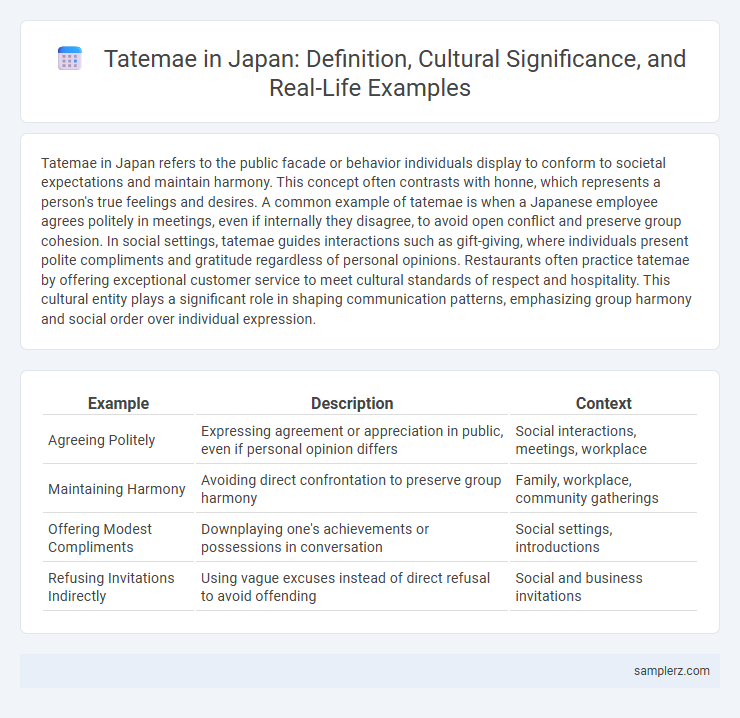Tatemae in Japan refers to the public facade or behavior individuals display to conform to societal expectations and maintain harmony. This concept often contrasts with honne, which represents a person's true feelings and desires. A common example of tatemae is when a Japanese employee agrees politely in meetings, even if internally they disagree, to avoid open conflict and preserve group cohesion. In social settings, tatemae guides interactions such as gift-giving, where individuals present polite compliments and gratitude regardless of personal opinions. Restaurants often practice tatemae by offering exceptional customer service to meet cultural standards of respect and hospitality. This cultural entity plays a significant role in shaping communication patterns, emphasizing group harmony and social order over individual expression.
Table of Comparison
| Example | Description | Context |
|---|---|---|
| Agreeing Politely | Expressing agreement or appreciation in public, even if personal opinion differs | Social interactions, meetings, workplace |
| Maintaining Harmony | Avoiding direct confrontation to preserve group harmony | Family, workplace, community gatherings |
| Offering Modest Compliments | Downplaying one's achievements or possessions in conversation | Social settings, introductions |
| Refusing Invitations Indirectly | Using vague excuses instead of direct refusal to avoid offending | Social and business invitations |
Common Tatemae Expressions in Japanese Daily Life
Common tatemae expressions in Japanese daily life include phrases like "Otsukaresama desu" to acknowledge colleagues' efforts and maintain workplace harmony, and "Sumimasen" used frequently to express apology or gratitude politely. These expressions help navigate social interactions by prioritizing group harmony and avoiding direct confrontation. Tatemae serves as a social lubricant, reflecting Japan's cultural emphasis on respect and indirect communication.
Tatemae in Japanese Workplace Etiquette
Tatemae in Japanese workplace etiquette manifests as employees maintaining a polite, harmonious demeanor during meetings, even when disagreements arise, to preserve group harmony and respect. Formal greetings, bowing, and indirect communication serve as expressions of tatemae, ensuring coworkers feel valued and conflicts are minimized. This practice upholds social order and demonstrates professionalism within Japan's corporate culture.
Social Gatherings: Demonstrations of Tatemae in Japan
In Japanese social gatherings, tatemae manifests as polite conversation and maintaining harmony despite personal feelings, such as expressing agreement outwardly to avoid conflict. Guests often compliment hosts insincerely to show respect, reflecting the cultural emphasis on group cohesion over individual opinion. This practice helps preserve social order and smooth interactions in both formal and informal settings.
Tatemae and Customer Service Interactions
Tatemae in Japan often manifests in customer service interactions, where employees maintain polite and harmonious communication despite personal feelings. This social facade prioritizes the customer's satisfaction and preserves group harmony, often resulting in overly formal language and deferential behavior. Such practices emphasize the cultural value placed on respect and indirect communication to avoid conflict.
Japanese Politeness: Tatemae in Greetings
Tatemae in Japanese greetings exemplifies the culture's emphasis on politeness and social harmony, where phrases like "Ogenki desu ka?" (How are you?) are often used regardless of personal feelings to maintain smooth interactions. This practice reflects an outward display of respect and consideration, masking true emotions or opinions, known as honne. Such politeness conventions are deeply ingrained in daily communication, reinforcing societal norms and relationships.
Tatemae During Confrontation Avoidance
Tatemae in Japan often manifests during confrontation avoidance, where individuals prioritize harmony by expressing polite agreement or withholding true opinions to maintain group cohesion. This social practice helps prevent direct conflicts and preserves face in both personal and professional settings. Understanding tatemae reveals the cultural emphasis on indirect communication and emotional restraint in Japanese society.
Tatemae in School and University Settings
Tatemae in Japanese school and university settings is often observed through polite expressions and behaviors masking true feelings to maintain group harmony. Students and faculty commonly engage in formal greetings and agree with prevailing opinions during discussions, even if privately they hold different viewpoints. This practice supports social cohesion and respects hierarchical relationships while subtly navigating personal sincerity.
Marriage and Relationships: Tatemae in Family Interactions
In Japanese culture, tatemae influences family interactions by prioritizing social harmony over honest expression, especially in marriage and relationships. Couples often display outward politeness and agreeableness to maintain peace, even if it contradicts their true feelings or desires. This social facade helps preserve the collective balance within the family and avoids conflict, reflecting the deep-rooted value of tatemae in Japanese familial dynamics.
Tatemae in Public Apologies and Press Conferences
Tatemae in Japan often manifests during public apologies and press conferences, where officials express remorse with carefully scripted language that prioritizes social harmony over personal feelings. These formal statements convey collective responsibility using polite, indirect phrases such as "deeply regret" (Shen kuoCha biShen shiShang gemasu) to maintain face and avoid direct confrontation. This practice reflects the cultural emphasis on preserving group cohesion and respect through controlled emotional expression.
Impact of Tatemae on Foreigners Living in Japan
Tatemae in Japan, representing the public facade or societal expectations, significantly impacts foreigners by shaping their interactions and integration within Japanese society. Foreign residents often face challenges adapting to indirect communication and unspoken social rules, which can lead to misunderstandings or feelings of isolation. Understanding tatemae is crucial for foreigners to navigate workplace dynamics, build relationships, and effectively participate in Japanese cultural and social settings.

example of **tatemae** in **Japan** Infographic
 samplerz.com
samplerz.com